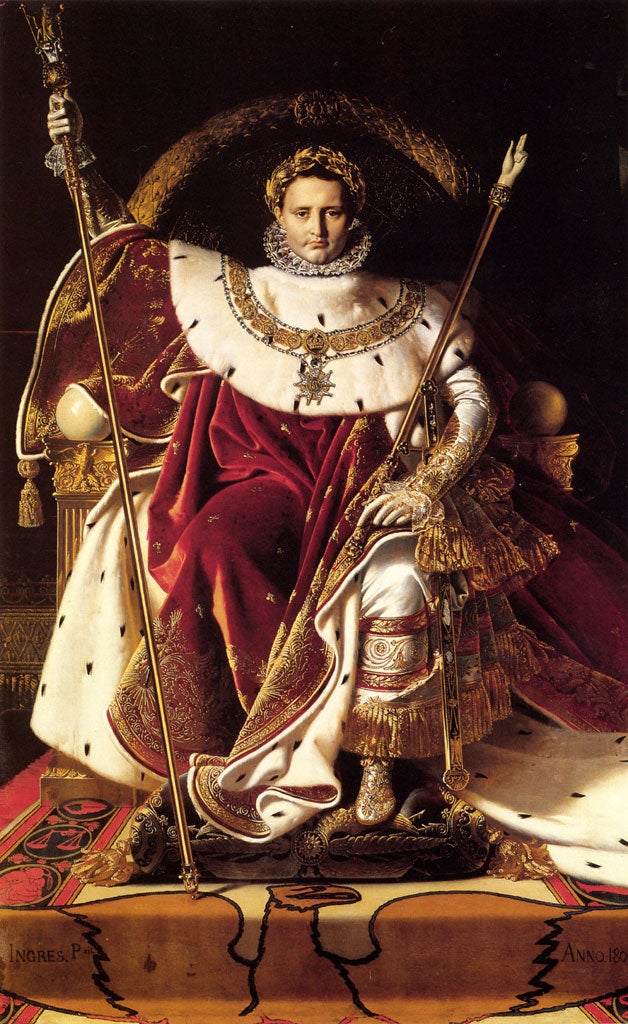Great Works: Napoleon I on his Imperial Throne, 1806 (259cm x 162 cm), Jean-Auguste-Dominique Ingres
Musée de l'Armée, Paris

Your support helps us to tell the story
From reproductive rights to climate change to Big Tech, The Independent is on the ground when the story is developing. Whether it's investigating the financials of Elon Musk's pro-Trump PAC or producing our latest documentary, 'The A Word', which shines a light on the American women fighting for reproductive rights, we know how important it is to parse out the facts from the messaging.
At such a critical moment in US history, we need reporters on the ground. Your donation allows us to keep sending journalists to speak to both sides of the story.
The Independent is trusted by Americans across the entire political spectrum. And unlike many other quality news outlets, we choose not to lock Americans out of our reporting and analysis with paywalls. We believe quality journalism should be available to everyone, paid for by those who can afford it.
Your support makes all the difference.There is something both thrilling and repugnantly strange about this grandiloquent portrait of Napoleon, queasily perched on his throne of self-glorification, by Jean -Dominique Ingres. It is huge when confronted face to face – in fact, its presence almost seems to bear down on us, cowing us into submission, as if we were so many grovelling minions at his court – but in reproduction, and quite surprisingly, we could almost imagine it to be as small as the span of a hand, because the symbolically over-adorned figure of the seated emperor himself rather puts us in mind, in spite of the overwhelming fuss of its opulent detailing, of an 18th-century figurine of the kind we might keep on the end of the mantelpiece. It has a kind of ceramic solidity to it, as if it is solidly grounded in its squat thinginess.
In fact, we wonder whether it is really a portrait of a man at all. How present is the body of Napoleon here? How much part does the idea of the body in its entirety play in this game of self-vaunting? We barely get a glimpse of it. The hands are a touch perfunctory; the outline of the knees, seen only through thick swathings of velvet which look, in their bunched, heavily heaped folds, as least as thick as carpeting, support the torso. It is only the head that is really present to our scrutinising eye.
And it is a terribly frozen head for all that, utterly, unflinchingly rigid and unyielding in its gaze, marmoreal- still. That head looks like an unwarm thing, such it is its pallor and its frigidity. Quite alarmingly so. This man has been reduced to the level of cold symbol – paradoxically so, given the warmth and richness of these velvets, that ermine baby's bib. He is not really here at all. Everything seems to have been contrived – and this painting is, at the very least, a massively staged contrivance – to rob him of his humanness, to transform him into a thing that transcends every idea of the merely human. This is a deathless man, one who has risen above us in order to utterly dominate our thinking, rule our lives. All five feet six inches of him. The head could be a death's head. The stare is completely inert, beyond seeing. All this tremendous symbolic clutter overwhelms the man.
But why is this painting so problematical as a portrait? It is something to do with the need on the part of the artist to establish, and to legitimize, the sudden emergence (or re-emergence) of the grandiloquent idea of empire after the murder of a king and the death of a republic. How should such a man/god be represented? What kind of objects would best show off what he was to seem to be to his subjects? The Bourbon model could scarcely be readmitted through the bloodied portal. What of past masters then? What of Charlemagne?
What was required, clearly, was the submersion of human fragility beneath an overwhelmingly fearful and intimidating display of historical bricolage.
ABOUT THE ARTIST
Jean-Auguste-Dominique Ingres (1780-1867) was one of the greatest and most compelling portraitists of the female figure of the 19th century. His work is strange and self-contradictory. Many have called him a realist, but that is to diminish his achievements, render them almost one-dimensional. Steeped in a knowledge of the great literature of the past, his range of subjects was huge: from literary subjects, through mythological reimaginings, to historical portraiture. He was perpetually striving to reinvent the possibilities of narrative painting in order to give it renewed power and legitimacy.
Join our commenting forum
Join thought-provoking conversations, follow other Independent readers and see their replies
Comments